A Methodology for Analysing Sustainability in Energy Scenarios
Abstract
:1. Introduction
2. Methodology
- External dependence from outside the country on the primary energy supply.
- Share of renewable energies in total energy consumption.
- Energy intensity as the ratio between energy consumption and gross domestic product, which is used to measure energy saving and efficiency.
- Total amount of CO2 emitted by each energy sector in the country.
3. Case Study: Democratic Republic of Congo
3.1. Energy Context of DRC
3.2. Comparison of Scenarios: BAU vs. HRES
4. Conclusions
Acknowledgments
Author Contributions
Conflicts of Interest
References
- Pinkse, J.; Groot, K. Sustainable Entrepreneurship and Corporate Political Activity: Overcoming Market Barriers in the Clean Energy Sector. Entrep. Theory Pract. 2015, 39, 633–654. [Google Scholar] [CrossRef]
- United Nations Development Programme (UNDP). Sharing Innovative Experience: Examples of Successful Uses of Renewable Energy Sources in the South; United Nations Development Programme (UNDP): New York, NY, USA, 2003. [Google Scholar]
- United Nations. Commercialization of Renewable Energy Technologies for Sustainable Development; United Nations: New York, NY, USA, 2000. [Google Scholar]
- World Bank. The World Bank’s Energy Program: Poverty Reduction, Sustainability, and Selectivity; World Bank: Washington, DC, USA, 2010; Available online: http://siteresources.worldbank.org/INTENERGY/Publications/20269216/energybrochure.pdf (accessed on 10 July 2017).
- International Energy Agency (IEA). World Energy Balances: Overview (2017 edition); International Energy Agency: Paris, France, 2017; Available online: http://www.iea.org/statistics/topics/energybalances/ (accessed on 10 August 2017).
- International Energy Agency (IEA). Energy for All: Financing Access for the Poor; International Energy Agency: Paris, France, 2011; Available online: http://www.worldenergyoutlook.org/media/weowebsite/energydevelopment/weo2011_energy_for_all.pdf (accessed on 10 July 2017).
- Ndubisi, N.O.; Nair, S.R. Green Entrepreneurship (GE) and Green Value Added (GVA): A Conceptual Framework. Int. J. Entrep. 2009, 13, 21–24. [Google Scholar]
- Pacheco, D.F.; Dean, T.J.; Payne, D.S. Escaping the green prison: Entrepreneurship and the creation of opportunities for sustainable development. J. Bus. Ventur. 2010, 25, 464–480. [Google Scholar] [CrossRef]
- Laes, E.; Gorissen, L.; Nevens, F. A comparison of energy transition governance in Germany, the Netherlands and the United Kingdom. Sustainability 2014, 6, 1129–1152. [Google Scholar] [CrossRef]
- Loken, E. Use of multicriteria decision analysis methods for energy planning problems. Renew. Sustain. Energy Rev. 2007, 11, 1584–1595. [Google Scholar] [CrossRef]
- Gulagi, A.; Bogdanov, D.; Fasihi, M.; Breyer, C. Can Australia Power the Energy-Hungry Asia with Renewable Energy? Sustainability 2017, 9, 233. [Google Scholar] [CrossRef]
- Grubb, M.; Edmunds, J.; ten Brink, P.; Morrison, M. The cost of limiting fossil-fuel CO2 emissions: A survey and analysis. Annu. Rev. Energy Environ. 1993, 8, 397–478. [Google Scholar] [CrossRef]
- Connolly, D.; Lund, H.; Mathiesen, B.V.; Leahy, M. A review of computer tools for analysing the integration of renewable energy into various energy systems. Appl. Energy 2010, 87, 1059–1082. [Google Scholar] [CrossRef]
- Hurtado, E.; Peñalvo-López, E.; Pérez-Navarro, A.; Vargas, C.; Alfonso, D. Optimization of a hybrid renewable system for high feasibility application in non-connected zones. Appl. Energy 2015, 155, 308–314. [Google Scholar] [CrossRef]
- Sánchez-Diaz, C.; Monrabal, J.; González, D.; Alfonso, D.; Peñalvo-López, E. Experimental results of the hydrogen production control of a hydrogen energy buffer. Int. J. Hydrogen Energy 2015, 40, 5013–5024. [Google Scholar] [CrossRef]
- Petrakopoulou, F. The Social Perspective on the Renewable Energy Autonomy of Geographically Isolated Communities: Evidence from a Mediterranean Island. Sustainability 2017, 9, 327. [Google Scholar] [CrossRef]
- Bioenergy and Food Security Projects (BEFS). Democratic Republic of the Congo, BEFS Country Brief; Bioenergy and Food Security Projects (BEFS): Rome, Italy, 2013; Available online: http://www.fao.org/3/a-aq170e.pdf (accessed on 10 July 2017).
- Taliotis, C.; Bazilian, M.; Welsch, M.; Gielen, D.; Howells, M. Grand Inga to power Africa: Hydropower development scenarios to 2035. Energy Strategy Rev. 2014, 4, 1–10. [Google Scholar] [CrossRef]
- International Energy Agency (IEA). Africa Energy Outlook; World Energy Outlook Special Report; Organization for Economic Co-Operation and Development (OECD)/International Energy Agency (IEA): Paris, France, 2014; Available online: https://www.iea.org/publications/freepublications/publication/WEO2014_AfricaEnergyOutlook.pdf (accessed on 10 July 2017).
- International Energy Agency (IEA). Country Statistics; International Energy Agency: Paris, France, 2016; Available online: https://www.iea.org/statistics/statisticssearch/report/?country=CONGOREP&product=balances&year=2014 (accessed on 10 July 2017).
- Singh, R.K.; Murty, H.R.; Gupta, S.K.; Dikshit, A.K. An overview of sustainability assessment methodologies. Ecol. Indic. 2012, 15, 281–299. [Google Scholar] [CrossRef]
- Cinelli, M.; Coles, S.R.; Kirwan, K. Analysis of the potentials of multi criteria decision analysis methods to conduct sustainability assessment. Ecol. Indic. 2014, 46, 138–148. [Google Scholar] [CrossRef]
- Benedict, B.A. Benefits of scenario planning applied to energy development. Energy Procedia 2017, 107, 304–308. [Google Scholar] [CrossRef]
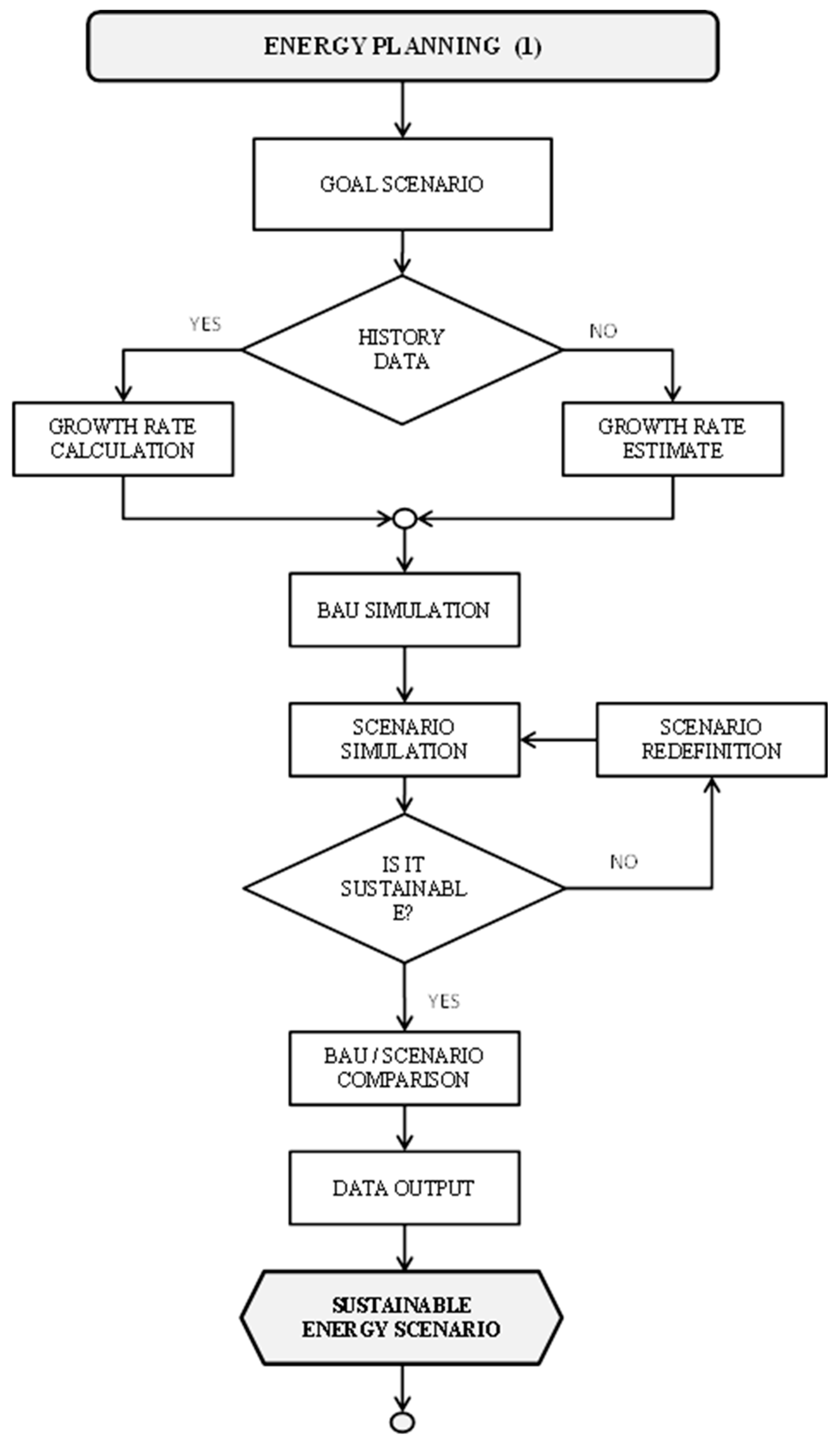




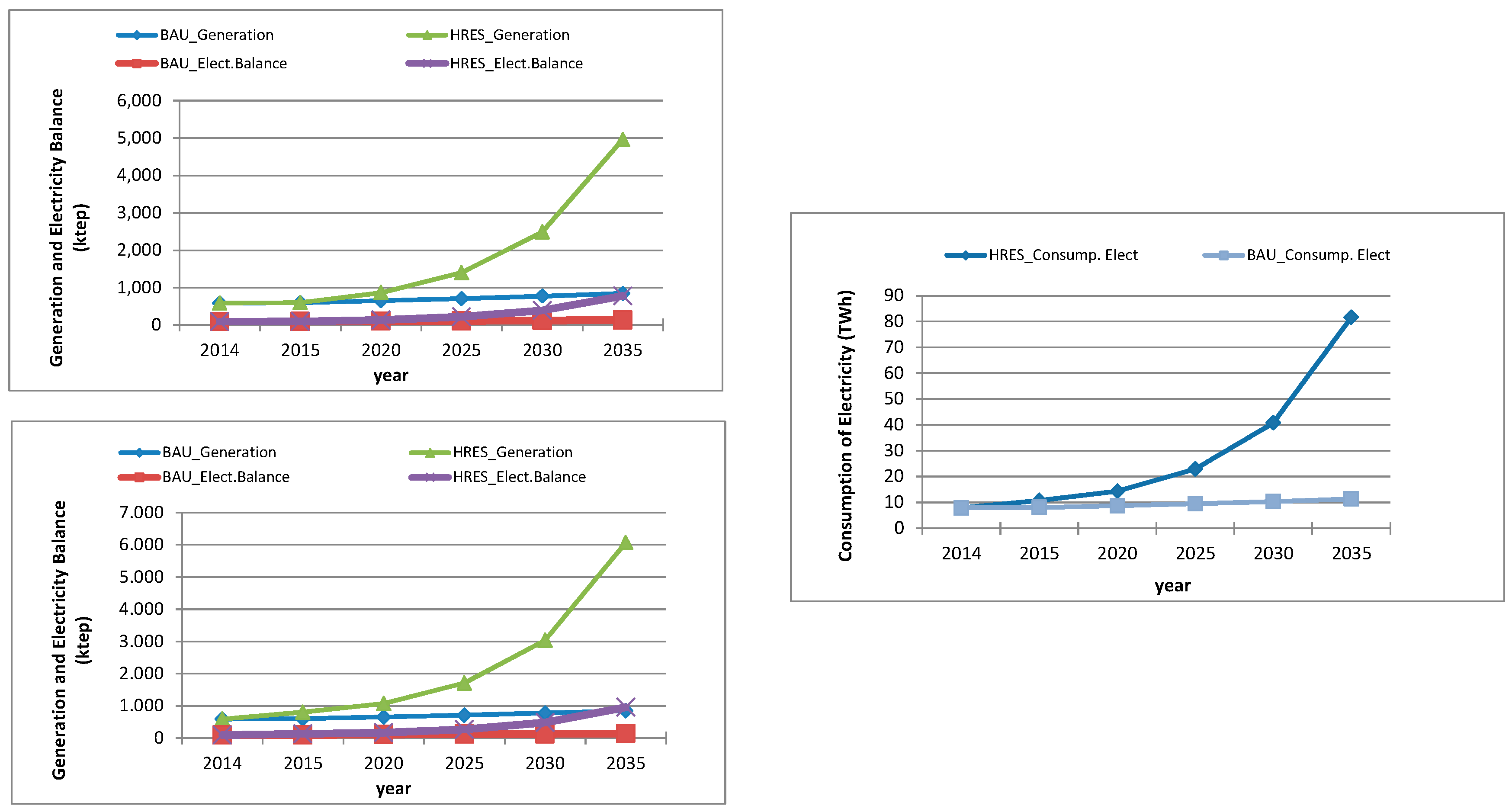
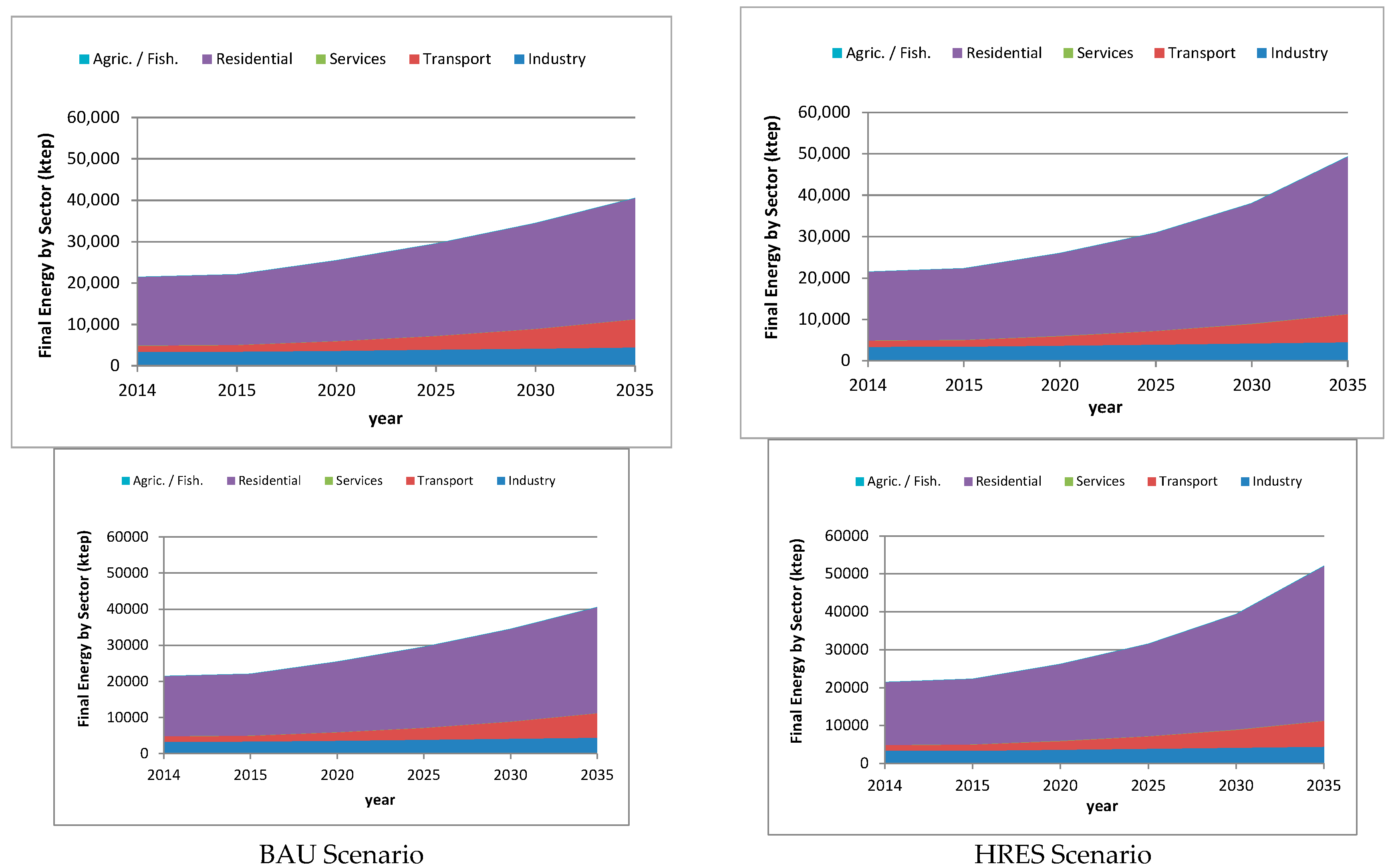
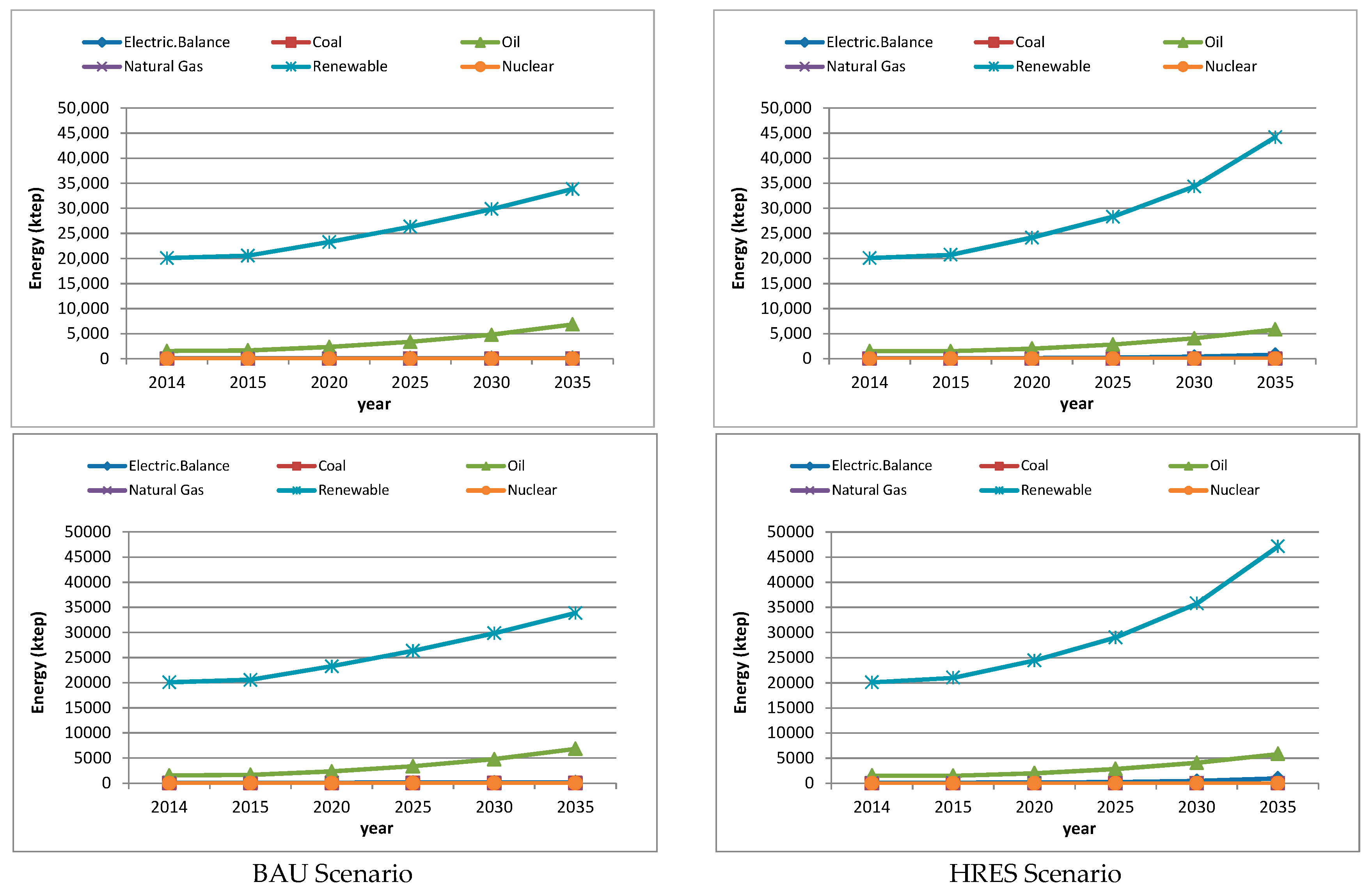
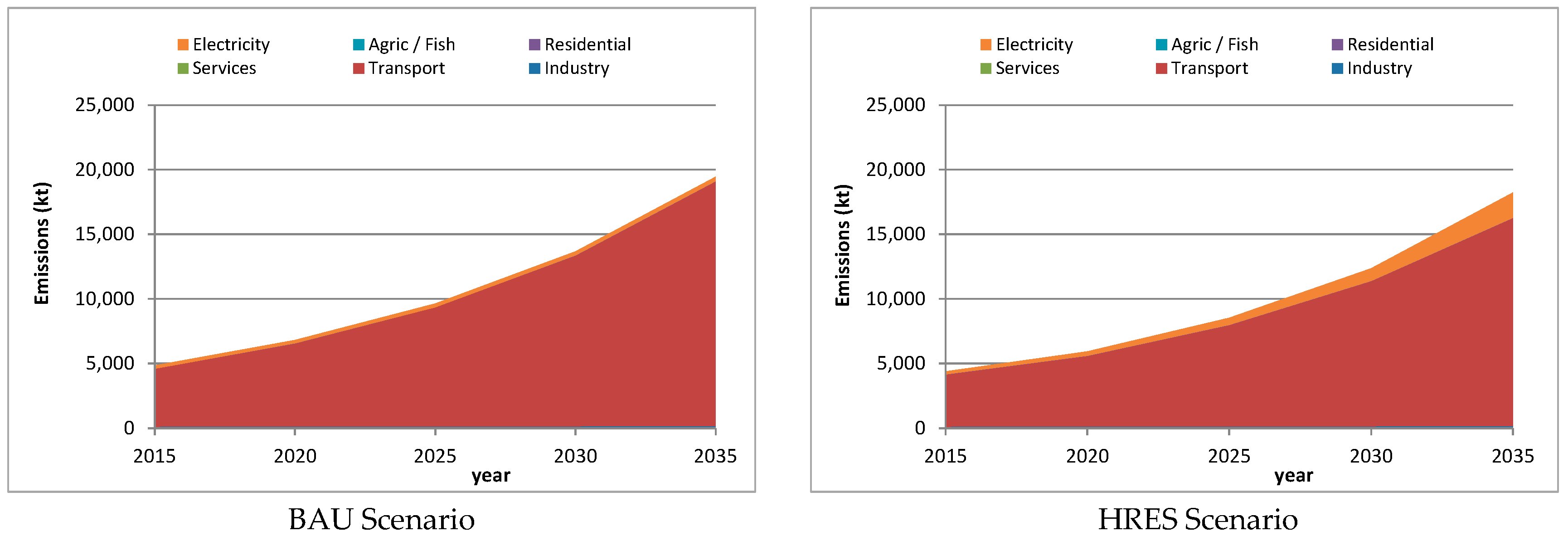
| Variable | Definition |
|---|---|
| P(t) | Population |
| GDP(t) | Gross domestic product |
| TEP(t) | Total Primary Energy |
| EP(t) | Evolution of the primary energy demand for each source: i = 1 (coal); i = 2 (oil); i = 3 (natural gas); i = 4 (renewable); i = 5 (nuclear); i = 6 (electricity generation) |
| DA(t) | Evolution of the final energy demand from each sector: j = 1 (transport); j = 2 (industrial); j = 3 (residential); j = 4 (services); j = 5 (agricultural and fishing); j = 6 (electricity generation) |
| TDA(t) | Evolution of total final energy demand from each sector |
| TEF(t) | Evolution of total final energy consumption |
| DR(i,j,t) | Evolution of the percentage of each source of energy (i) in the demand of a particular sector (j) |
| TEM(t) | Evolution of total CO2 emissions |
| EM(i,j,t) | Evolution of the CO2 emissions due to the use of a particular source of energy (i) in a demand sector (j) |
| SEM(t) | Evolution of the total CO2 emissions from sector j |
| CEM(i,j) | Emission coefficients due to the energy (i) use in the sector (j) |
| R(j,t) | Growth rate evolution for the energy demand in the sector (j) and for the population (j = 7) and the GDP in j = 8. |
| Economic Sector | Growth Rate (%) | Other | Growth Rate (%) |
|---|---|---|---|
| Industry | 1.4 | Population | 3.1 |
| Transport | 7.5 | GDPppp | 0.4 |
| Services | 0.5 | ||
| Residential | 2.7 | ||
| Agric./Fish. | 0.1 |
| Variables | Units | 2014 | 2015 | 2020 | 2025 | 2030 | 2035 |
|---|---|---|---|---|---|---|---|
| Population | Million | 74.9 | 77.2 | 89.9 | 104.6 | 121.8 | 141.8 |
| GDPppp | M€2010 | 52,200,000 | 52,412,599 | 53,488,650 | 54,586,794 | 55,707,483 | 56,851,180 |
| Consumption of Electricity | TWh | 7.9 | 8.0 | 8.7 | 9.5 | 10.4 | 11.3 |
| CO2 Emissions | Mt | 4.53 | 4.85 | 6.82 | 9.64 | 13.68 | 19.45 |
| Primary Energy (EP) | ktep | 28,713 | 29,520 | 33,978 | 39,265 | 45,586 | 53,214 |
| EP Generated | ktep | 20,057 | 20,558 | 23,264 | 26,344 | 29,852 | 33,848 |
| Import-Export | ktep | 92 | 94 | 102 | 111 | 121 | 132 |
| Generated Electricity | ktep | 587 | 597 | 648 | 706 | 771 | 843 |
| Exterior Dependency | % | 30.15 | 30.36 | 31.53 | 32.91 | 34.51 | 36.39 |
| GDPppp/capita | M€2010/inhab | 0.70 | 0.68 | 0.60 | 0.52 | 0.46 | 0.40 |
| TEP/capita | tep/hab | 0.383 | 0.382 | 0.378 | 0.375 | 0.374 | 0.375 |
| TEP/GDPppp | tep/M€2010 | 0.55 | 0.56 | 0.64 | 0.72 | 0.82 | 0.94 |
| Electricity/capita | kWh/inhab | 0.11 | 0.10 | 0.10 | 0.09 | 0.09 | 0.08 |
| CO2/TEP | t/tep | 0.16 | 0.16 | 0.20 | 0.25 | 0.30 | 0.37 |
| CO2/GDPppp | t/M€2010 | 0.09 | 0.09 | 0.13 | 0.18 | 0.25 | 0.34 |
| CO2/capita | t/inhab | 0.060 | 0.063 | 0.076 | 0.092 | 0.112 | 0.137 |
| Fraction ER in EP* | % | 69.9 | 69.6 | 68.5 | 67.1 | 65.5 | 63.6 |
| Fraction ER in EE* | % | 86.5 | 86.5 | 86.5 | 86.5 | 86.5 | 86.5 |
| Variables | Units | 2014 | 2015 | 2020 | 2025 | 2030 | 2035 |
|---|---|---|---|---|---|---|---|
| Population | Million | 74.9 | 77.2 | 89.9 | 104.6 | 121.8 | 141.8 |
| GDPppp | M€2010 | 52,200,000 | 52,412,599 | 53,488,650 | 54,586,794 | 55,707,483 | 56,851,180 |
| Consumption of Electricity | TWh | 7.9 | 8.1 | 11.6 | 18.8 | 33.5 | 66.7 |
| CO2 Emissions | Mt | 4.53 | 4.40 | 5.94 | 8.53 | 12.37 | 18.22 |
| Primary Energy (EP) | ktep | 28,713 | 29,524 | 34,675 | 41,107 | 50,315 | 64,915 |
| EP Generated | ktep | 20,057 | 20,721 | 24,156 | 28,320 | 34,347 | 44,195 |
| Import-Export | ktep | 92 | 94 | 136 | 219 | 390 | 778 |
| Generated Electricity | ktep | 587 | 600 | 865 | 1,400 | 2,488 | 4,961 |
| Exterior Dependency | % | 30.15 | 29.81 | 30.34 | 31.11 | 31.74 | 31.92 |
| GDPppp/capita | M€2010/inhab | 0.70 | 0.68 | 0.60 | 0.52 | 0.46 | 0.40 |
| TEP/capita | tep/hab | 0.383 | 0.382 | 0.386 | 0.393 | 0.413 | 0.458 |
| TEP/GDPppp | tep/M€2010 | 0.55 | 0.56 | 0.65 | 0.75 | 0.90 | 1.14 |
| Electricity/capita | kWh/inhab | 0.11 | 0.10 | 0.13 | 0.18 | 0.27 | 0.47 |
| CO2/TEP | t/tep | 0.16 | 0.15 | 0.17 | 0.21 | 0.25 | 0.28 |
| CO2/GDPppp | t/M€2010 | 0.09 | 0.08 | 0.11 | 0.16 | 0.22 | 0.32 |
| CO2/capita | t/inhab | 0.060 | 0.057 | 0.066 | 0.082 | 0.102 | 0.128 |
| Fraction ER in EP* | % | 69.9 | 70.2 | 69.7 | 68.9 | 68.3 | 68.1 |
| Fraction ER in EE* | % | 86.5 | 86.5 | 86.5 | 86.5 | 86.5 | 86.5 |
© 2017 by the authors. Licensee MDPI, Basel, Switzerland. This article is an open access article distributed under the terms and conditions of the Creative Commons Attribution (CC BY) license (http://creativecommons.org/licenses/by/4.0/).
Share and Cite
Peñalvo-López, E.; Cárcel-Carrasco, F.J.; Devece, C.; Morcillo, A.I. A Methodology for Analysing Sustainability in Energy Scenarios. Sustainability 2017, 9, 1590. https://doi.org/10.3390/su9091590
Peñalvo-López E, Cárcel-Carrasco FJ, Devece C, Morcillo AI. A Methodology for Analysing Sustainability in Energy Scenarios. Sustainability. 2017; 9(9):1590. https://doi.org/10.3390/su9091590
Chicago/Turabian StylePeñalvo-López, Elisa, Francisco Javier Cárcel-Carrasco, Carlos Devece, and Ana Isolda Morcillo. 2017. "A Methodology for Analysing Sustainability in Energy Scenarios" Sustainability 9, no. 9: 1590. https://doi.org/10.3390/su9091590
APA StylePeñalvo-López, E., Cárcel-Carrasco, F. J., Devece, C., & Morcillo, A. I. (2017). A Methodology for Analysing Sustainability in Energy Scenarios. Sustainability, 9(9), 1590. https://doi.org/10.3390/su9091590







